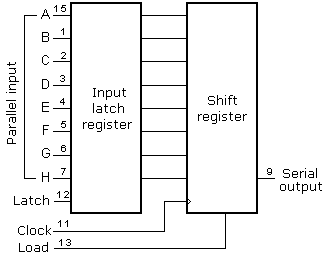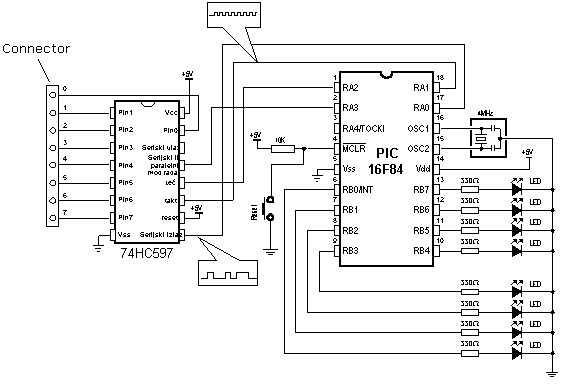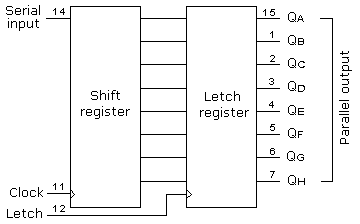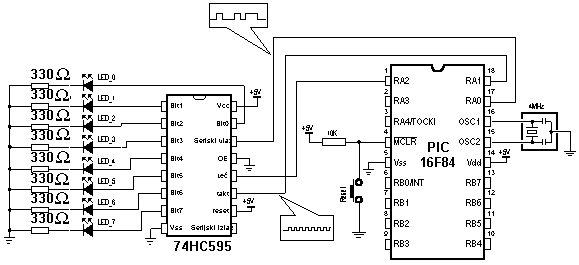Shift registers
There are two types of shift registers: input and output. Input shift registers receive data in parallel, through 8 lines and then send it serially through two lines to a microcontroller. Output shift registers work in the opposite direction; they receive serial data and on a "latch" line signal, they turn it into parallel data. Shift registers are generally used to expand the number of input-output lines of a microcontroller. They are not so much in use any more though, because most modern microcontrollers have a large number of pins. However, their use with microcontrollers such as PIC16F84 is very important.
7.7.1 Input shift register 74HC597
Input shift registers transform parallel data into serial data and transfers it to a microcontroller. Their working is quite simple. There are four lines for the transfer of data: Clock, Latch, Load and Data. Data is first read from the input pins by an internal register through a 'latch' signal. Then, with a 'load' signal, data is transferred from the input latch register to the shift register, and from there it is serially transferred to a microcontroller via 'data' and 'clock' lines.

An outline of the connection of the shift register 74HC597 to a micro, is shown below.

In order to simplify the main program, a
macro can be used for the input shift register. Macro HC597 has two
parameters:
HC597 macro Var, Var1
Var variable where data from shift register input pins is transferred
Var1 loop counter
Example: HC597 data, counter
Data from the input pins of the shift register is stored in data variable. Timer/counter variable is used as a loop counter.
Macro listing:
HC597 MACRO VAR,VARL
LOCAL LOOP ;Local label
MOVLW .8 ;Transfer eight bits
MOVWF VARL ;initializing counter
BSF LATCH ;Receive pin states into input latch
NOP
BCF LATCH
BCF LOAD ;Transfer the contents of input latch to
NOP ;SHIFT reg.
BSF LOAD
LOOP
RLF VAR,F ;Rotate "Var" one place to the left
BTFSS DATAA ;Is Data line = "1" ?
BCF VAR,0 ;If not, clear bit '0' in Var
BTFSC DATAA ;Is Data line = "0" ?
BSF VAR,0 ;If not, set bit '0'
BSF CLOCK ;Generate one clock
NOP
BCF CLOCK
DECFSZ VARL,F ;Has 8 bits been received ?
GOTO LOOP ;If not, repeat
ENDM
Example of how to use the HC597 macro is given in the following program. Program receives data from a parallel input of the shift register and moves it serially into the RX variable of the microcontroller. LEDs connected to port B will indicate the result of the data input.
PROCESSOR 16f84
#include "P16F84.inc"
__CONFIG _CP_0FF & _WDT_0FF & _PWRTE_0N & _XT_0SC
CBLOCK OXOC ;RAM starting address
RX
COUNTSPI
ENDC
#DEFINE DATAA PORTA,0 ;Any other I/O pin could be used
#DEFINE CLOCK PORTA, 1
#DEFINE LATCH PORTA, 2
#DEFINE LOAD PORTA,3
ORG 0X00 ;Reset vector
GOTO MAIN
ORG 0X04 ;Interrupt vector
GOTO MAIN ;no interrupt routine
#include "hc597.inc"
MAIN ;Beginning of the program
BANKSEL TRISA
MOVLW B'00010001' ;initializing port A
MOVWF TRISA ;TRISA <- 0x11
CLRF TRISB ;Pins of porta B are output
BANKSEL PORTA
CLRF PORTA ;PORTA <- 0x00
BSF LOAD ;Enable SHIFT register
LOOP
HC597 RX, COUNTSPI ;States of input pins of SHIFT reg.
MOVF RX,W ;are stored in variable RX
MOVWF P0RTB ;Set the content of RX reg. to port B
GOTO LOOP ;Repeat the loop
END ;End of program
7.7.2 Output shift register

Output shift registers transform serial data into parallel data. On every rising edge of the clock, the shift register reads the value from data line, stores it in temporary register, and then repeats this cycle 8 times. On a signal from 'latch' line, data is copied from the shift register to input register, thus data is transformed from serial into parallel data.
An outline of the 74HC595 shift register connections is shown on the diagram below:

Macro used in this example can be found
in hc595.inc file, and is called HC595.
Macro HC595 has two parameters:
HC595 macro Var, Var1
Var variable whose contents is transferred to outputs of shift
register.
Var1 loop counter
Example: HC595 Data, counter
The data we want to transfer is stored in data variable, and counter
variable is used as a loop counter.
HC595 MACRO VAR,VARL
LOCAL LOOP ;Local label
MOVLW .8 ;Transfer eight bits
MOVWF VARL ;Initialising counter
RLF VAR,F ;Rotate "Var" on place to the left
BTFSS STATUS,C ;Is carry = "1" ?
BCF DATAA ;If not, set Dataa line to "0"
BTFSC STATUS,C ;Is carry = "0" ?
BSF DATAA ;If not, set Dataa line to "1"
BSF CLOCK ;Generate one clock
NOP
BCF CLOCK
DECFSZ VARL,F ;Has eight bits been sent ?
GOTO LOOP ;If not, repeat
BSF LATCH ;If all 8 bits have been sent,
NOP ;contents of SHIFT register to send the output latch
BCF LATCH
ENDM
An example of how to use the HC595 macro is given in the following program. Data from variable TX is serially transferred to shift register. LEDs connected to the parallel output of the shift register will indicate the state of the lines. In this example value 0xCB (1100 1011) is sent so that the seventh, sixth, third, first, and zero LEDs are illuminated.
PROCESSOR 16f84
#include "pl6f84.inc"
__CONFIG _CP_0FF & _TODT_0FF & _PWRTE_0N & _XT_0SC
CBLOCK 0X0C ;RAM starting address
TX ;Belongs to the function "HC595"
COUNTSPI
ENDC
#DEFINE DATAA PORTA, 0
#DEFINE CLOCK PORTA, 1
#DEFINE LATCH PORTA,2
ORG 0X00 ;Reset vector
GOTO MAIN
ORG 0X04 ;Interrupt vector
GOTO MAIN ;no interrupt routine
INCLUDE "HC595.INC"
MAIN ;Beginning of the program
BANKSEL TRISA
MOVLW B'00011000' ;Initialising port A
MOVWF TRISA ;TRISA <- 0x18
BANKSEL PORTA
CLRF PORTA ;PORTA <- 0x00
MOVLW 0XCB ;Fill TX buffer
MOVWF TX ;TX <- '11001011'
HC595 TX, COUNTSPI
LOOP
GOTO LOOP ;Remain at this line
END ;End of program
User Comments
No Posts found !Login to Post a Comment.